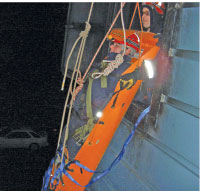
Against the Ropes: Training and personal challenges in adventure work
By Emily Roback BSc DC
Features Education ProfessionThe frustrating reality of rope and air rescue is the failure of those in charge to communicate effectively with health professional volunteers who are expressing an interest in serving patients. Inexperienced and untrained rescue volunteers from the health professions – however well intentioned – are often not able to operate at their optimum level, as an effective support team with others who are learning to become rescuers.
 |
| Dr. Emily Roback practises her rope skills at the Red Deer Search and Rescue Headquarters Training Centre. Photos by Rick Henderson |
The frustrating reality of rope and air rescue is the failure of those in charge to communicate effectively with health professional volunteers who are expressing an interest in serving patients. Inexperienced and untrained rescue volunteers from the health professions – however well intentioned – are often not able to operate at their optimum level, as an effective support team with others who are learning to become rescuers.
The immediate needs of rescue training often relate to communication and back safety issues. Chiropractic services are usually competently provided in collaboration with, or as part of a structured rescue response team. Volunteer chiropractors are most successful during the aftermath of a ground and air search, provided they arrive on the scene as part of a prearranged response team and have already been trained in wilderness medicine, rope rescue, spotting, and navigation.
RESCUE TRAINING – KNOT FOR THE UNPREPARED!
According to Apps (2004) “adventure [work] is increasing and some participants will inevitably develop musculoskeletal problems.”(1) This is especially true in rescue training programs. The rope rescue course in Red Deer, Alberta, which is operated by Red Deer Search-and-Rescue Technical Team, runs the only rope training course in central Alberta. Military personnel and professional climbers instruct two- to three-day weekend courses. Trainees spend five to six days tying knots, rappelling, and pulling heavy sledges from the ground to the top of a four-storey building, while working in extreme sub-zero conditions. The Canadian Air Search and Rescue Association, a group of air rescue pilots in Red Deer County, run their navigation and spotter courses throughout the year. For trainees who have acquired their CPR and/or First Aid Certificates, a wilderness medicine course is offered.
There are no minimum prerequisites for trainees who must be able to pull or lift the sledge from the ground level. The average trainee is young and active – some have climbed the Rocky Mountains – self-reliant, as well as having a ruthless determination to achieve success, having spent immeasurable amount of time mastering patient packaging, mechanical systems, hand signals, and tying rope knots correctly.
 |
| A team of six rescuers practises belaying, rapelling, tying a harness on a patient, and lowering a patient from the second floor of a four-storey building. |
To protect their back, trainees must learn to avoid lifting with the low back flexed. Trainees are strongly advised to lightly contract the stabilizing abdominal musculature to reduce the risk of back injury (McGill, 2002).(2)
Also, miscommunication between team members could be significantly reduced by making oral and sign language mandatory. For instance, one trainee is belaying for a lead climber and a second trainee is watching the leader climb down the wall of a 400 foot cliff. The second trainee must provide the leader instructions via voice and hand signals to overcome poor hearing circumstances due to large climbing distances. The first trainee (a.k.a., belayer for the leader) must always watch and listen to the instructions coming from the second trainee who is observing the leader climb down the side of the cliff.
PERSONAL CHALLENGES
My previous rescue training experiences have included learning the basics of rope rescue at Rattlesnake Point, a cliff located 30 kilometres south of Toronto, Ontario.
The catch to this operation for me was that I undertook this outdoor course without any hearing.
As a deaf chiropractor, I have had to learn how to live with a hearing loss which constantly fluctuates every passing year. For five to six months, I would hear with my hearing aids perfectly. For the remainder of the year, my hearing would drop to nil, which forced me to rely on lip-reading and body language for communication.
What I really enjoyed most about this training experience was the fact that my rescue teammates used hand signals to communicate with me, and that I was able to incorporate chiropractic care into their daily training regimes.
CASE STUDIES:
THE VALUE OF CHIROPRACTIC IN SEARCH-AND-RESCUE
This article describes two clinical cases of how valuable chiropractic can be in search-and-rescue.

|
| Two rescuers in training practise lowering and raising a patient in sked (a.k.a. sledge). |
Case 1: A 37-year-old-male (medical technician) had complained of acute low-back pain. Orthopaedic testing indicated a positive Gaeslen Test and Posterior Sacral Iliac Compression Test. The condition was diagnosed as bilateral sacral iliac joint dysfunction. His pain was resolved with chiropractic in two visits.
Case 2: A 42-year-old male (rescue technician) had reduced neck mobility with right forearm and hand numbness. Several trigger points were found in the anterior scalenes, triceps and brachioradialis muscles on the right side. Mild degeneration was noted in the cervical spine at C5 and C6 level. The condition was related to an upper extremity nerve entrapment. His neck pain and hand numbness resolved with three chiropractic visits.
Without doubt, chiropractic is a useful addition to the usual conservative medical approaches implemented in rescue training camps. As a recent graduate of the Canadian Memorial Chiropractic College, I believe chiropractic is a effective approach in acheiving a speedy recovery for back pain without the use of anti inflamitory medications. Other conditions such as headaches and neck pain can also be treated.
References:
1) Apps, J. Polar Acupuncture.
Acupuncture in Medicine. 2002: 22(3): 156-158.
2) McGill, S. Low Back Disorders: Evidence-Based Prevention and Rehabilitation. Human Kinetics. 2002. (textbook)
 Dr. Emily Roback, president of Chiroback Trekker, provides chiropractic, sports therapy and injury prevention seminars for search-and-rescue teams in Alberta. Dr. Roback can be contacted at roback@doctor.com and/or 403-872-1599.
Dr. Emily Roback, president of Chiroback Trekker, provides chiropractic, sports therapy and injury prevention seminars for search-and-rescue teams in Alberta. Dr. Roback can be contacted at roback@doctor.com and/or 403-872-1599.
Print this page